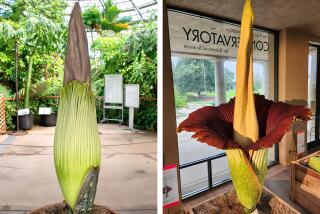At the Huntington, a Japanese Garden of new delights
Gloria Cox may be a grandmother, but she’s grinning like a little kid as she slips into a shady nook formed by twining juniper branches in the Japanese Garden at the Huntington Library, Art Collections and Botanical Gardens. Cox, a veteran Huntington docent, says she has missed visiting “my favorite spot” — which she discovered with her grandsons — and the rest of the garden, which closed for renovation last April and is reopening Wednesday in time for its centennial.
The Japanese Garden is welcoming back old friends like Cox and hoping to attract new ones with $6.8 million in improvements that include the installation of a ceremonial teahouse and tea garden and restoration of the late 19th century-style Japanese House.
Magnate Henry E. Huntington created this retreat of pines, ponds and wisteria in a canyon on his San Marino estate from 1911 to 1912. Officials say it is one of the most popular destinations on the estate, which opened to the public in 1928. “The Huntington has changed over time, but the garden hasn’t lost its mystique,” says James Folsom, director of the botanical gardens. “On Yelp, it gets more comments than ‘Blue Boy’ or the Gutenberg Bible.”
The Huntington sees this anniversary as a chance to take a fresh look at the 9-acre site’s past and future. Folsom says research for the renovations and a centennial history book due out this fall “have led us to keep learning more” about subjects such as the house’s construction and the garden’s relationships with local Japanese Americans.
While hoping to preserve the garden’s mystique, he adds, “We’ve been developing a more complete mission for it. We create these landscapes for public enjoyment but use them to expose people to the beauty of many Japanese garden arts that have been adopted by a much broader community.”
This mission “fits squarely with what’s happening with Japanese gardens across the country,” says Kendall Brown, a historian of Japanese gardens in North America and a professor of Asian art history at Cal State Long Beach. In the late 1800s and early 1900s, he says, world’s fair versions of Japanese gardens and commercial tea gardens inspired a vogue for “exotic environments.” In the postwar era, however, “People wanted to build what they thought was authentic. But in the late 20th and now 21st centuries, we realize that authenticity in style is a kind of nebulous or problematic idea. And so, gardens in America are moving away from the concept of authenticity and concentrating more on creating learning environments.”
Brown, a contributor to the Huntington’s book, notes that the Japanese Garden is actually three gardens: the original stroll garden with ponds and a moon bridge, the raked-gravel dry garden added in 1968, and the traditionally landscaped tea garden.
“The Huntington connects with the history of Japanese gardens in America — commercial tea gardens, estate gardens, cultural institutions, women’s guilds as patrons and ‘60s Zen gardens,” Brown says, as well as with changing perspectives. “From our viewpoint now, we see gardens like Henry Huntington’s were Americanized versions of Japanese gardens, reflecting American needs and American ideas about Japan.”
Huntington — urged on by his superintendent, William Hertrich — converted his canyon to follow the fashion of the time and perhaps, says Brown, to impress his future wife, Arabella. He bought plants and ornamental features from a failed commercial tea garden in Pasadena that had been opened several years earlier by art dealer George Turner Marsh.
One notable transplant from Pasadena was the five-room wooden Japanese House, much of which the Huntington believes was shipped from Japan to California and assembled at the tea garden.
Chiyozo and Tsune Goto, an immigrant couple who had worked for Marsh, lived in the Huntington garden and served as its caretakers for at least a year and a half. They and their three sons stayed in a cottage behind the house, says author and journalist Naomi Hirahara, who writes about the Gotos in the upcoming book.
Hirahara also will tell the story of Toichiro Kawai, a Pasadena master carpenter born and trained in Japan. He disassembled the Marsh house and reconstructed it in San Marino, where he built the moon bridge and a bell tower. Noting that Kawai’s granddaughter, Leslie Kawai, was named 1981 Rose Queen, Hirahara says that “after doing the research for the article, I realized — especially with the addition of the teahouse, which was given by the Pasadena Buddhist Temple — the Huntington represents a century-long arc of Japanese American history in this area.”
Folsom says the Japanese Garden and other Huntington gardens felt the effects of Depression- and World War II-era cutbacks. During the war, the Japanese Garden was called “the Oriental Garden,” neglected areas were closed to the public and the Japanese House was shuttered and fell into disrepair. In the late ‘50s, he adds, Huntington trustees and the San Marino League, the garden’s main philanthropic group, worked to refurbish and reopen the house in what was again known as the Japanese Garden.
In the decades since the house reopened, Folsom says, “The garden underwent a renaissance” with the additions of the dry garden and bonsai and suiseki (“viewing stones”) areas and increases in cultural programming. The centennial project involves more than 100 American and Japanese architects, designers, construction workers, artisans and gardeners. Funding came from individuals and foundations, including money from a $2.6-million bequest from Mary B. Hunt, a longtime garden supporter.
Work on the house, which Folsom says was badly in need of restoration, was led by Long Beach-based preservation architect Kelly Sutherlin McLeod. Other improvements include repairs to the aging walkways and water system. The 3/4-acre tea garden was designed by Takuhiro Yamada of Kyoto in collaboration with local landscape architects Takeo Uesugi and his son, Keiji Uesugi. The Uesugis also oversaw the landscape design for the project, which includes a new waterfall.
The tea garden is home to an Urasenke teahouse, which had resided at the Pasadena temple for more than four decades. (Urasenke is one of the three main schools of tea ceremony. The finely crafted structure — named Seifu-an (“Arbor of Pure Breeze”) — was constructed in Kyoto in 1964. After its donation in 2010, it was restored in Japan and reassembled here under the supervision of Kyoto-based architect and craftsman Yoshiaki Nakamura, the son of its builder.
The teahouse and tea garden are significant parts of “the new vision for the Japanese Garden,” says Folsom. “It’s fitting we start the next century by adding elements that represent a centuries-old tradition from Japan and a gift from a Japanese American Buddhist temple.”
More to Read
The biggest entertainment stories
Get our big stories about Hollywood, film, television, music, arts, culture and more right in your inbox as soon as they publish.
You may occasionally receive promotional content from the Los Angeles Times.










